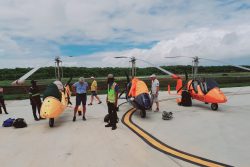Although backing a gas-to-shore project here, main opposition coalition partner the Alliance for Change (AFC) on Friday warned that the current plan being pursued by the PPP/C government at Wales is not supported by the research done so far.
“We therefore demand that further detailed studies be conducted before the country is saddled with its largest ever PPP white elephant,” AFC General Secretary David Patterson told a news conference, where he underscored that the Wales location had been rejected by previous studies.
“Importantly, none of the studies commissioned under the coalition administration recommends the site selected by the PPP/C… As a matter of fact, it is important to note that Wales was considered among 10 sites but rejected in the studies,” Patterson added.
The government has said the estimated US$810-900 million project will produce power at around US 7 cents per KWH compared to US14 cents that the Guyana Power and Light is producing at but it has faced scrutiny over the selection of the Wales location.
Government has also announced that it has negotiated with ExxonMobil to increase the minimum commitment of gas from 30 MCFD (Million Cubic Feet per Day) to 50 MCFD thereby moving the net potential power from 150 MW to 250MW.
Patterson said the projected costs of US$900 million is exclusive of costs for power generating plants as well as transmission of the power to GPL power distribution stations.
“The studies utilised by the PPP listed the costs for the power plants and transmission lines to be US$240 million and US$85 million respectively – which would make the total project cost approximately – US$1.225 billion [a sum which] will be added to Exxon’s cost recovery total during the next four years,” he said.
Patterson stressed that the coalition used the same studies to plan a project that produced 188MW of power plus 2,200 barrels of LNG daily for a price tag of under US$600 million – half the amount that the PPP is pursuing.
Further, he noted that while the quantity of gas (50mfd) being proposed to be utilized by the PPP will only be guaranteed available for 11 years, the 30mfd which APNU+AFC planned to use will be fully available for 18 years.
“That’s correct folks, we will be paying US$112 million per year for this PPP project for a lifespan of eleven years – makes any sense to you?” he questioned.
Patterson noted that the PPP has presented a proposal to install a Liquefied Natural Gas (LNG) plant which it is claimed will produce approximately 3,400 barrels per day. However, he said that in 2020, Guyana’s total Liquefied Petroleum Gas (LPG) usage was approximately only 2,000 barrels per day, while the PPP has decided on a plant without the provision of any plans for utilisation of the excess volumes. “The studies clearly state that exporting this small amount is not economically viable,” he said, before adding that under the coalition government, studies had commenced to assess the possibilities of powering the revised public transportation system with excess gas. Unless such studies are completed, he said, any decisions on the gas to shore project remain premature and incomplete.
‘Woodlands over Wales’
He later released to the public a study commissioned by ExxonMobil which concluded that the Wales location was less suitable than a location at Woodlands, West Coast Berbice.
According to the undated “Powerplant Location Assessment Update,” a two-week field based assessment of Woodlands and Vreed-en-Hoop along with its associated industrial area of Wales found that Woodlands offers fewer constraints overall.
Specifically, the report concludes that it would cost approximately US$72 million more to develop and land the pipeline at Vreed-en-Hoop and construct the powerplant at Wales.
Concerns raised in the assessment update include the technical complexity related to landing the pipelines up river of the power plant. The study also noted that shallow water installation by anchored barge will restrict access to ship channels for two to three months while there would remain a high risk of marine traffic encroaching on the anchor lines.
“Pipeline would need to be buried 2-3 meters, possibly deeper if there are any plans to deepen the river; trenching barge will likely struggle with currents at the mouth of the river [and] 90 degree turn from the river into the plan is a significant installation challenge,” it adds.
In total, extra costs for locating the project at Wales was projected to include US$15 million for the transmission line, US$10 million for the MVA new-build substation and US$25-$35 million for a low pressure gas line.
Cost estimates for the Woodland sites assumed that the pipeline would come ashore at Clonbrook, East Coast Demerara, which the study states is within sufficient distance of the projected industrial site.
“Inclusion of a broader Woodlands area would not affect costs as onward power/gas infrastructure requirements are negligible,” it concludes.
The only category of constraint within which Woodlands outstripped Wales was the impact on biodiversity since the West Berbice Mangrove was found to be of a higher concentration value and more bio-diverse.
In fact, according to the report both landing sites, Vreed-en-hoop and Clonbrook, were found to be similarly prone to flooding.
Vice President Bharrat Jagdeo had claimed last Monday that the Wales location was chosen because the studies conducted under the APNU+AFC administration determined its suitability against flooding and the high population density of other sites identified, in addition to its expansion potential.
This is, however, a direct contrast to the contents of three of the five studies released by the PPP/C and the sixth study released by Patterson.
Following the findings of the ExxonMobil location assessment, a 2017 update of Guyana’s “Generation Expansion Study” by Colombian company Brugman S A S reported that “Woodlands was the most promising landing site of the proposed pipeline.” This study was funded by the Inter-American Development Bank.
Another IDB study, which was conducted in 2018 by United Kingdom company Energy Narrative, utilised these conclusions to determine that the gas-to-shore project was both economically and financially feasible.
The study, titled “Overall feasibility study for Guyana’s Offshore Natural Gas Pipeline, LPG separation plant and related electricity infrastructure,” noted that Woodlands was selected as the landing site after an extensive site selection process, led by a cross-agency team including representatives from the Guyana Energy Agency, Guyana Power & Light, the Ministry of Natural Resources, the Ministry of Business, the Ministry of Public Infrastructure, the Guyana Lands & Surveys Commission, and the Maritime Administration Department.
The 2018 study was an update of a 2017 desk study of the “Options, Cost, Economics, Impacts, and Key Considerations of Transporting and Utilising Natural Gas from Offshore Guyana for the Generation of Electricity”.
That 2017 study had concluded that Clonbrook was an optimal landing site for the 30 MMscfd [million standard cubic feet per day] pipeline. Woodlands was found to have the benefit of sufficient area (roughly 476 acres) for the planned natural-gas-fired power plant, the NGL separation and LPG production plant, and a potential industrial park.
“The site is not located near a port, however, and will require extensive site development work owing to the poor soil conditions at the location,” Energy Narrative added.
The primary objective of the 2018 study was to determine the overall feasibility of transporting natural gas from offshore Guyana, building an NGL separation and LPG production plant to market the liquids from the natural gas stream, and building a new electricity generation station to use the remaining dry natural gas.
Among the conclusions reached were that an offshore natural gas pipeline was economically viable.
“Economic cost-benefit analysis (CBA) finds that the offshore natural gas pipeline has an aggregate net present value (NPV) of approximately US$782 million and an economic rate of return of 30% percent under the project’s Base Case assumptions,” it stated, before adding that a sensitivity analysis performed to estimate how changes in key variables would impact economic feasibility found that the project remains feasible in every scenario.
“The pipeline shows the highest economic return under the 50 MMscf per day of natural gas volumes and the high oil price case, reaching nearly US$2.8 billion in net present value and a 52% economic rate of return,” it further noted.
According to Patterson, the coalition based its decision to utilise the lower quantity of 30mfd not only because of cost but particularly because of its commitment to transition the country to one hundred per cent renewables by 2040. “The Power Generation Study completed by the Coalition, provided a roadmap to this transition, with the introduction of a mid-scale hydro plant project by 2030. The decision to expend an additional US$600M at the expense of six years guaranteed gas supply is quite frankly – “voodoo economics,”” he added.










